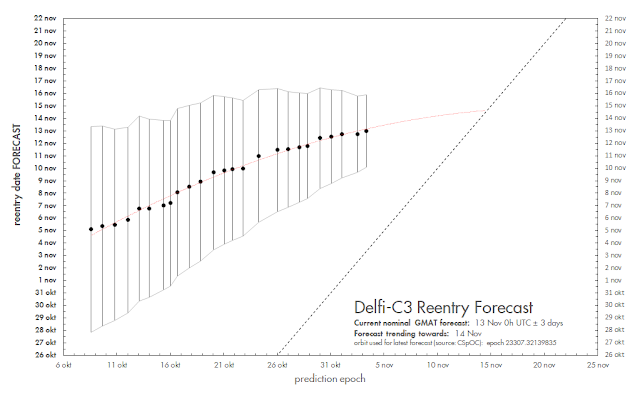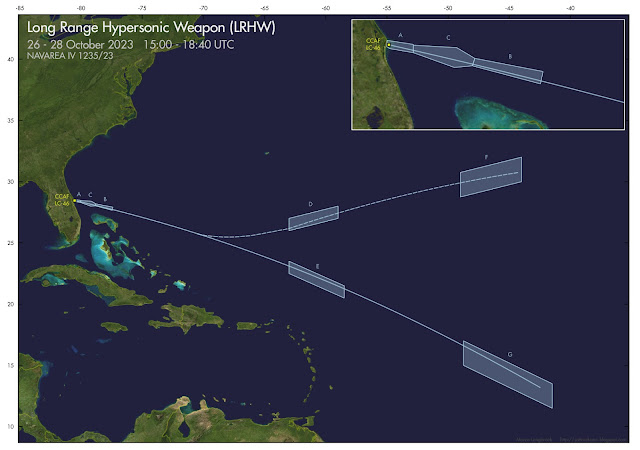 |
| Delfi-C3 tracklet on a stack of 16 video frames, 24 Oct 2023 |
(note: new reentry forecasts are now published in a separate dedicated blogpost)
Earlier this year, my TU Delft colleague Stefano Speretta asked me if I could try to I imaged a pass of the TU Delft-built 3U cubesat Delfi-C3 (2008-021G).
It next took a long time due to initially unfavourable observing geometries and - when the observing geometries got better - the Dutch weather, but I finally managed to successfuly image it in late evening twilight of 24 October 2023.
Above is a stack of 16 video frames showing the tracklet created by the cubesat; below is the actual video footage, shot with a WATEC 902H2 Supreme camera and Samyang 2.0/135 mm lens at 25 fps (the object is very faint in the footage, due to it being very small in size):
Delfi-C3 (2008-021G) is a 3U cubesat and was the first cubesat built in the Netherlands. It was launched on 28 April 2008 from Satish Dawan in India on a PSLV rocket, as part of a rideshare mission.
It was built by students of Delft Technical University (my current employer) as the first in what was to become a line of Dutch-designed-and-built cube- and pocketsats. It carried at that time experimental technology (autonomous star sensors and thin-film solar panels) and an amateur radio responder. More information on the cubesat, its mission and the technology onboard can be found at the TU Delft website.
Although no longer operational, there is occasionally still radio telemetry received from the cubesat by our TU Delft Rooftab Radio lab.
 |
| Delfi-C3 in stowed condition (image: TU Delft) |
 |
| Delfi-C3in deployed condition (image: TU Delft) |
Fifteen years after launch, it is time to say Goodbye this very successful cubesat. It has less than half a month to live.
[post NO LONGER UPDATED below. Instead refer to this new dedicated post here for new reentry forecast updates]
Initially launched into a 615 x 635 km, 98.0 inclined orbit, the orbit has now decayed to 321 x 324 km (status as of 3 Nov 2023), and the cubesat is coming down increasingly fast, as can be seen in the diagrams below (currently, the orbit is dropping by 4 km/day (status 3 Nov 2023)):
 |
| click diagrams to enlarge |
 |
| click diagram to enlarge |
Delfi-C3 will probably reenter into the atmosphere and burn up somewhere mid-November 2023 (depending on how solar activity develops over November).
Here is the evolution of my GMAT reentry forecast so far (ignore the error bars and quoted reentry date uncertainty for now, as this far before reentry they still have little meaning, due to the uncertainty in future solar activity):
 |
| click diagram to enlarge |
The initial shift of the forecast over time towards a progressively later date is slowing down. My best guess at this moment (3 Nov2023) is reentry mid-November, around 12-14 November 2023, plus-minus a few days.
I will update this figure over the coming days and weeks, as the reentry forecast develops.
New reentry forecasts are now published in a separate dedicated blogpost.
I do not expect a TIP to be issued for this object. Recent experience shows that TLE updates will probably cease some 2-3 days before the actual reentry, after which CSpOC issues an 'administrative decay'.
Delfi-C3 is very small and the reentry will be completely harmless, with the cubesat burning up completely.









